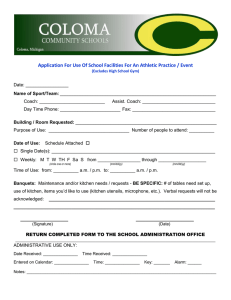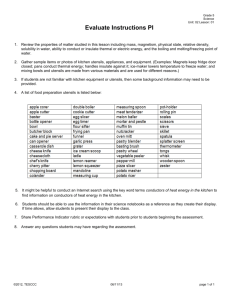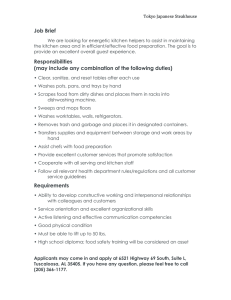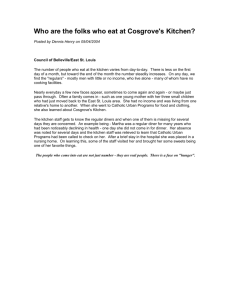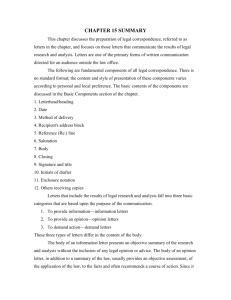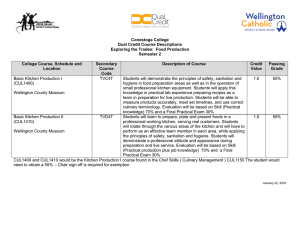An Electrophysiological Study of Object-Based Correspondence Effects:
advertisement
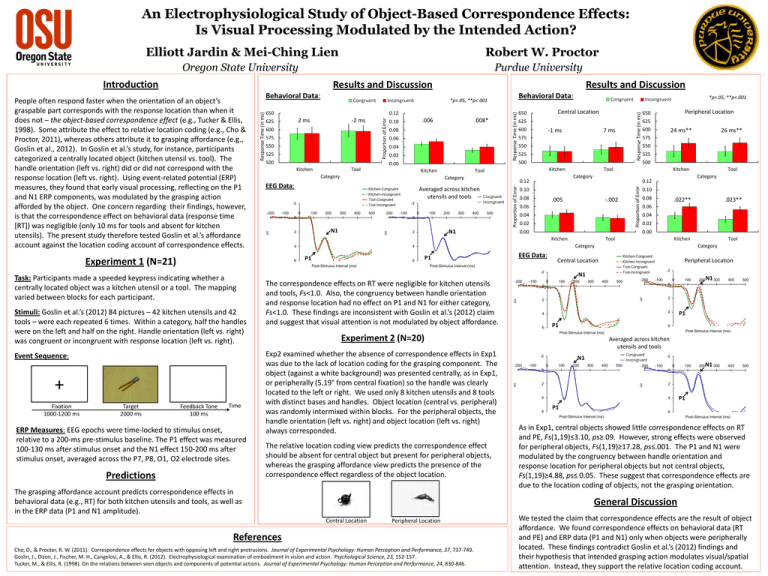
An Electrophysiological Study of Object-Based Correspondence Effects: Is Visual Processing Modulated by the Intended Action? Elliott Jardin & Mei-Ching Lien Robert W. Proctor Oregon State University Purdue University Results and Discussion 0.12 -2 ms Proportion of Error 2 ms 600 575 550 525 500 .006 0.10 0.08 0.06 0.04 0.02 0.00 Kitchen Tool Kitchen Category -2 0 100 200 300 400 500 -200 0 100 200 300 400 500 0 N1 2 uv uv 0 -100 N1 2 600 -1 ms 550 525 500 Category 4 .005 6 6 0.04 0.02 EEG Data: P1 Fixation 1000-1200 ms Target 2000 ms Feedback Tone 100 ms Time ERP Measures: EEG epochs were time-locked to stimulus onset, relative to a 200-ms pre-stimulus baseline. The P1 effect was measured 100-130 ms after stimulus onset and the N1 effect 150-200 ms after stimulus onset, averaged across the P7, P8, O1, O2 electrode sites. Predictions 26 ms** Kitchen Tool 575 550 525 500 Category 0.10 0.08 .022** .023** Kitchen Tool 0.06 0.04 0.02 Tool Category Central Location Peripheral Location Post-Stimulus Interval (ms) -100 N1 0 100 The relative location coding view predicts the correspondence effect should be absent for central object but present for peripheral objects, whereas the grasping affordance view predicts the presence of the correspondence effect regardless of the object location. The grasping affordance account predicts correspondence effects in behavioral data (e.g., RT) for both kitchen utensils and tools, as well as in the ERP data (P1 and N1 amplitude). 200 300 400 500 -200 -100 0 0 0 2 2 4 4 P1 6 100 200 N1 300 400 500 P1 6 Post-Stimulus Interval (ms) Post-Stimulus Interval (ms) Experiment 2 (N=20) Averaged across kitchen utensils and tools -2 -200 -100 -2 N1 0 100 200 300 400 500 -200 -100 0 0 0 2 2 uv Exp2 examined whether the absence of correspondence effects in Exp1 was due to the lack of location coding for the grasping component. The object (against a white background) was presented centrally, as in Exp1, or peripherally (5.19° from central fixation) so the handle was clearly located to the left or right. We used only 8 kitchen utensils and 8 tools with distinct bases and handles. Object location (central vs. peripheral) was randomly intermixed within blocks. For the peripheral objects, the handle orientation (left vs. right) and object location (left vs. right) always corresponded. -2 uv uv The correspondence effects on RT were negligible for kitchen utensils and tools, Fs<1.0. Also, the congruency between handle orientation and response location had no effect on P1 and N1 for either category, Fs<1.0. These findings are inconsistent with Goslin et al.’s (2012) claim and suggest that visual attention is not modulated by object affordance. -200 uv + 24 ms** 0.00 0.00 -2 Event Sequence: 600 Category Post-Stimulus Interval (ms) Stimuli: Goslin et al.’s (2012) 84 pictures – 42 kitchen utensils and 42 tools – were each repeated 6 times. Within a category, half the handles were on the left and half on the right. Handle orientation (left vs. right) was congruent or incongruent with response location (left vs. right). -.002 0.06 4 P1 625 0.12 0.10 0.08 Peripheral Location 650 Tool Kitchen Experiment 1 (N=21) Task: Participants made a speeded keypress indicating whether a centrally located object was a kitchen utensil or a tool. The mapping varied between blocks for each participant. 7 ms 575 0.12 Proportion of Error -100 625 Kitchen Averaged across kitchen utensils and tools -2 *p<.05, **p<.001 Central Location 650 Tool Category EEG Data: -200 .008* Response Time (in ms) *p<.05, **p<.001 650 625 Behavioral Data: Response Time (in ms) Behavioral Data: Response Time (in ms) People often respond faster when the orientation of an object’s graspable part corresponds with the response location than when it does not – the object-based correspondence effect (e.g., Tucker & Ellis, 1998). Some attribute the effect to relative location coding (e.g., Cho & Proctor, 2011), whereas others attribute it to grasping affordance (e.g., Goslin et al., 2012). In Goslin et al.’s study, for instance, participants categorized a centrally located object (kitchen utensil vs. tool). The handle orientation (left vs. right) did or did not correspond with the response location (left vs. right). Using event-related potential (ERP) measures, they found that early visual processing, reflecting on the P1 and N1 ERP components, was modulated by the grasping action afforded by the object. One concern regarding their findings, however, is that the correspondence effect on behavioral data (response time [RT]) was negligible (only 10 ms for tools and absent for kitchen utensils). The present study therefore tested Goslin et al.’s affordance account against the location coding account of correspondence effects. Results and Discussion Proportion of Error Introduction 4 6 4 P1 100 N1 300 200 400 500 P1 6 Post-Stimulus Interval (ms) Post-Stimulus Interval (ms) As in Exp1, central objects showed little correspondence effects on RT and PE, Fs(1,19)≤3.10, ps≥.09. However, strong effects were observed for peripheral objects, Fs(1,19)≥17.28, ps≤.001. The P1 and N1 were modulated by the congruency between handle orientation and response location for peripheral objects but not central objects, Fs(1,19)≥4.88, ps≤ 0.05. These suggest that correspondence effects are due to the location coding of objects, not the grasping orientation. General Discussion Central Location Peripheral Location References Cho, D., & Proctor, R. W. (2011). Correspondence effects for objects with opposing left and right protrusions. Journal of Experimental Psychology: Human Perception and Performance, 37, 737-749. Goslin, J., Dizon, J., Fischer, M. H., Cangelosi, A., & Ellis, R. (2012). Electrophysiological examination of embodiment in vision and action. Psychological Science, 23, 152-157. Tucker, M., & Ellis, R. (1998). On the relations between seen objects and components of potential actions. Journal of Experimental Psychology: Human Perception and Performance, 24, 830-846. We tested the claim that correspondence effects are the result of object affordance. We found correspondence effects on behavioral data (RT and PE) and ERP data (P1 and N1) only when objects were peripherally located. These findings contradict Goslin et al.’s (2012) findings and their hypothesis that intended grasping action modulates visual/spatial attention. Instead, they support the relative location coding account.
